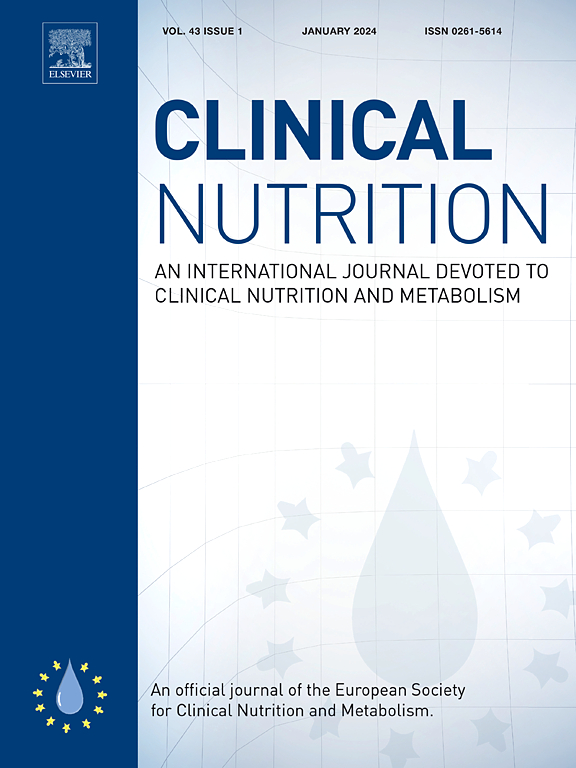Effects of synbiotics surpass probiotics alone in improving type 2 diabetes mellitus: A randomized, double-blind, placebo-controlled trial
IF 6.6
2区 医学
Q1 NUTRITION & DIETETICS
引用次数: 0
Abstract
Background and aims
Combining probiotics and prebiotics in synbiotics may present a synergistic approach to improve type 2 diabetes mellitus (T2DM); however, further evidence is required to establish the comparative efficacy of synbiotics versus probiotics. This study aimed to evaluate the effects of Bifidobacterium animalis subsp. lactis MN-Gup (MN-Gup) and a synbiotic mixture of MN-Gup and galactooligosaccharide (MN-Gup-GOS) on glycemic control in T2DM patients and explore possible mechanisms.
Methods
This randomized, double-blind, placebo-controlled clinical trial assigned 120 T2DM patients, to receive MN-Gup, MN-Gup-GOS, or placebo intervention for 12 weeks. The primary outcome was fasting blood glucose (FBG), with secondary outcomes including hemoglobin A1C (HbA1C), insulin, homeostatic model assessment of insulin resistance (HOMA-IR), inflammatory indicators, oxidative stress indicators, gastrointestinal hormones, gut microbiota, and bile acids (BAs).
Results
The median age of the 120 participants was 59 years (interquartile range: 55–62 years), with 40 being men. Compared to baseline, all three groups exhibited significant reductions in FBG. Additionally, the MN-Gup-GOS group demonstrated significant decreases in HbA1c, serum insulin, and HOMA-IR after intervention, whereas no such reductions were observed in the placebo and MN-Gup groups. Regarding the between-group comparisons, the MN-Gup-GOS intervention showed a significantly greater reduction in FBG compared to the placebo (least squares mean difference [95 % CI], −0.69 [-1.29, −0.10] mmol/L, P = 0.022) and MN-Gup (−0.59 [-1.17, −0.01], P = 0.047) group, but not for other indicators of glucose metabolism. Additionally, MN-Gup and MN-Gup-GOS intervention, especially the latter, significantly modified inflammation, oxidative stress, gut microbiota, serum BAs, and GLP-1 levels. Correlation analysis showed significant associations between changes in certain gut microbiota (Bifidobacterium) and BAs (deoxycholic acid and lithocholic acid) with glycemic indicators.
Conclusions
The auxiliary effect of synbiotics MN-Gup-GOS on reducing FBG levels surpassed that of MN-Gup probiotics alone in T2DM patients, potentially attributed to the enhanced modulation of gut microbiota, BAs, and GLP-1 secretion.
Trial registration
This study was registered on the website of www.chictr.org.cn, number ChiCTR2100052187.
一项随机、双盲、安慰剂对照试验:合成益生菌在改善2型糖尿病方面的作用超过单独使用益生菌。
背景与目的:益生菌与益生元合用可能是改善2型糖尿病(T2DM)的协同途径;然而,需要进一步的证据来确定合成菌与益生菌的比较功效。本研究旨在评价动物双歧杆菌亚种的作用。乳酸菌MN-Gup (MN-Gup)和MN-Gup与半乳糖低聚糖(MN-Gup- gos)的合成混合物对T2DM患者血糖的控制作用并探讨可能的机制。方法:这项随机、双盲、安慰剂对照的临床试验分配了120名T2DM患者,接受MN-Gup、MN-Gup- gos或安慰剂干预12周。主要终点是空腹血糖(FBG),次要终点包括血红蛋白A1C (HbA1C)、胰岛素、胰岛素抵抗稳态模型评估(HOMA-IR)、炎症指标、氧化应激指标、胃肠激素、肠道微生物群和胆胆酸(BAs)。结果:120名参与者的中位年龄为59岁(四分位数范围:55-62岁),其中40名为男性。与基线相比,所有三组的空腹血糖均显著降低。此外,MN-Gup- gos组在干预后显示HbA1c、血清胰岛素和HOMA-IR显著降低,而安慰剂组和mn - group组没有观察到这种降低。在组间比较方面,与安慰剂组相比,MN-Gup- gos干预组的空腹血糖降低显著高于安慰剂组(最小二乘平均差[95% CI], -0.69 [-1.29, -0.10] mmol/L, P = 0.022)和MN-Gup组(-0.59 [-1.17,-0.01],P = 0.047),但其他葡萄糖代谢指标则无显著差异。此外,MN-Gup和MN-Gup- gos干预,特别是后者,显著改善炎症、氧化应激、肠道微生物群、血清BAs和GLP-1水平。相关分析显示,某些肠道菌群(双歧杆菌)和BAs(去氧胆酸和石胆酸)的变化与血糖指标有显著相关性。结论:在T2DM患者中,合成益生菌MN-Gup- gos对降低FBG水平的辅助作用超过了单独使用MN-Gup益生菌,可能归因于肠道微生物群、BAs和GLP-1分泌的增强调节。试验注册:本研究注册网站为www.chictr.org.cn,注册号为ChiCTR2100052187。
本文章由计算机程序翻译,如有差异,请以英文原文为准。
求助全文
约1分钟内获得全文
求助全文
来源期刊

Clinical nutrition
医学-营养学
CiteScore
14.10
自引率
6.30%
发文量
356
审稿时长
28 days
期刊介绍:
Clinical Nutrition, the official journal of ESPEN, The European Society for Clinical Nutrition and Metabolism, is an international journal providing essential scientific information on nutritional and metabolic care and the relationship between nutrition and disease both in the setting of basic science and clinical practice. Published bi-monthly, each issue combines original articles and reviews providing an invaluable reference for any specialist concerned with these fields.
 求助内容:
求助内容: 应助结果提醒方式:
应助结果提醒方式:


